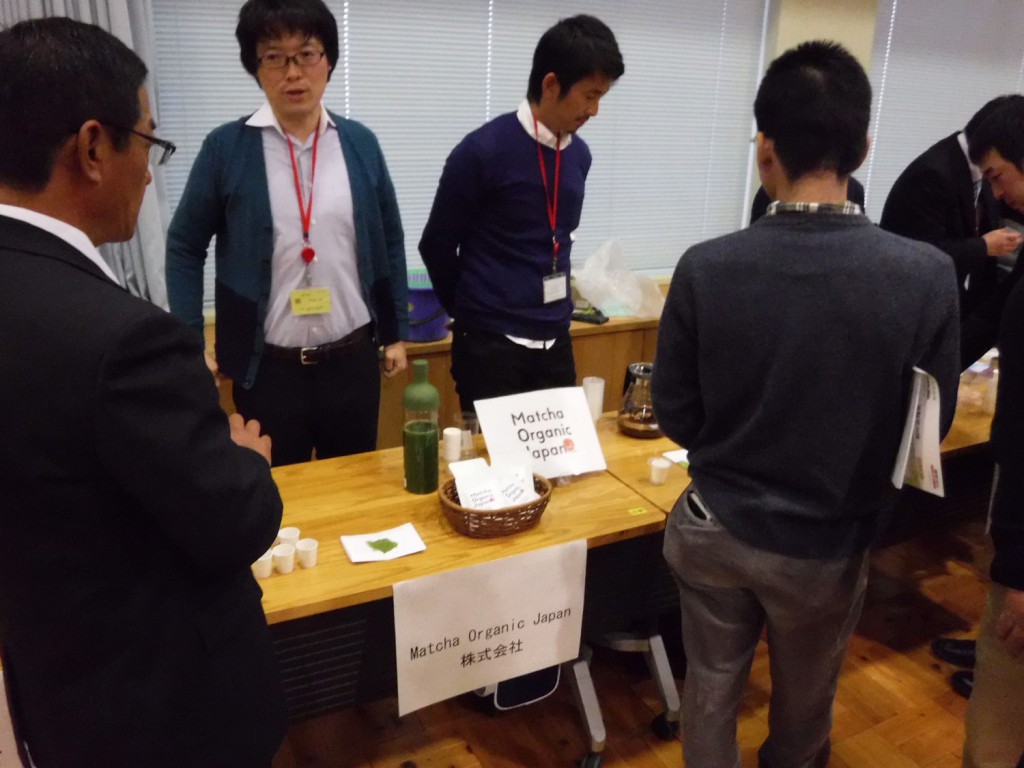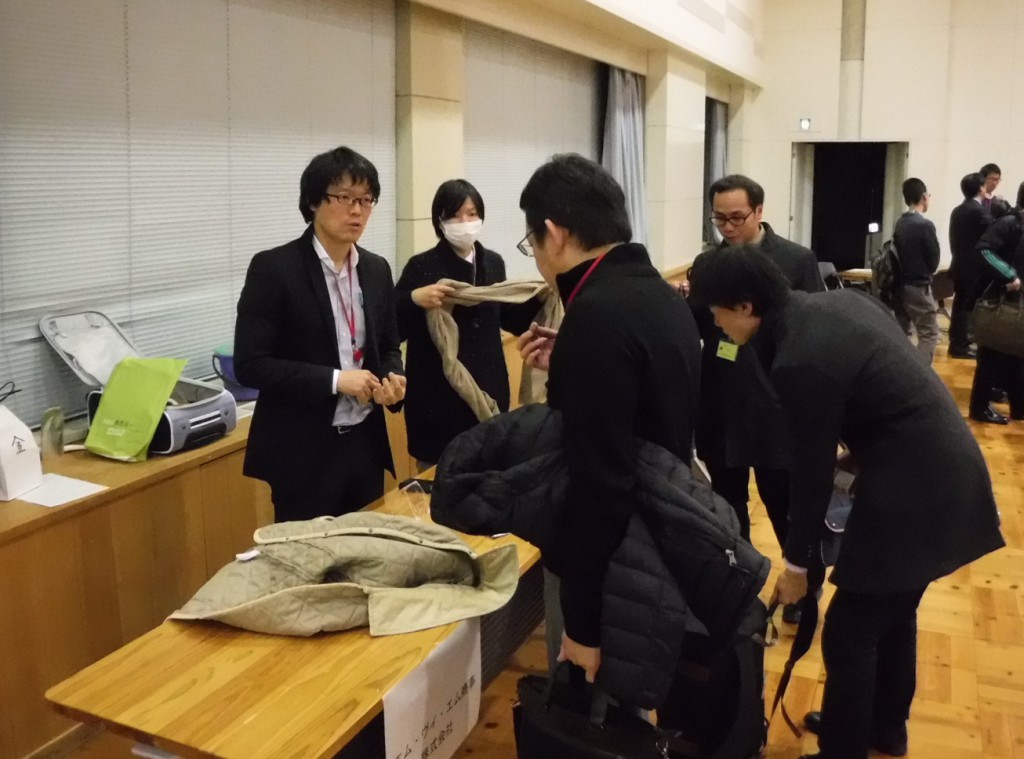In the Organic Tea Power Up Meeting, various business persons joined and discussed each other, including tea farmers, tea merchants, tea and agriculture machinery companies, agricultural consultants etc. The number of participants was more than 230, indicating the great concerns for organic tea production.
In the session for discussion and tea tasting, various tea farmers and tea merchants exhibited their products.
1. Matcha Organic Japan
Matcha Organic Japan Co., Ltd. has established by young tea farmers under 40 years old in Kawane and Shimada tea estates in Shizuoka pref. since 2016. They have searched adequate tea plantations, which are abandoned or nearly abandoned tea plantations and located far from conventional tea farms to avoid drift contamination of agrichemicals. And now they cultivate organic tea in the adequate farmlands already lent or bought by themselves. In addition to their main purpose, supplying organic matcha to worldwide markets, they also aim to activate the local tea industry and related businesses, besides consequently preserve farmlands as tea plantations in their tea estates.
In the conference, Mr. Murata exhibited their matcha produced in 2016. In fact, he is one of the members in Kikusui Tea Production Cooperative at the same time. He contributes the production of deep steamed Sencha green tea in the cooperative and matcha production in Matcha Organic Japan.

Although he brought a small portions of matcha for retail at that time, they also prepare larger scale (a few kilograms) of matcha for wholesale.

2. Kamairi-cha Shibamoto
Though Mr. Shibamoto could not participate the seminar, his colleague exhibited his tea products. Unfortunately, his booth has so much participants that I could not see and talk with his colleague.
In the presentation by MAFF officer, his management of tea plantation was introduced as one of the excellent practices. As posted before, he controls the density of tea green leafhoppers by optimization of plucking later tea shoots in the first flush period. Green leafhopper is the insect which suck the sap of tea plants, causing the decrease in tea yield. On the other hand, their sucking sap stimulates tea leaves, resulting in the generation of aroma like fruits.
Mr. Shibamoto keeps the adequate density of tea green leafhoppers by optimizing plucking plan. The density of the insects starts t increase from May, the later period of first flush. In the period, “later tea shoots” of first flush grows enough to be plucked. Green tea leafhoppers suck the sap of “later tea shoot” of first flush. Mr. Shibamoto hand-plucks the later tea shoots when the density of insects increase enough to enhance the aroma generation due to the stimulation of sucking sap. Because of the distribution of growth rate of later tea shoots, green tea leafhoppers can move to the other part of tea plantation where enough amount of later tea shoot growing. Because of lower migration speed of green tea leafhopper, hand-plucking of later tea shoots along with plucking order of first flush could keep the adequate density of green tea leafhopper in each tea plantation, so he keeps the density of insect enough to enhance the aroma generation and not to cause severe decrease of yield. He produce highly aromatic oolong tea using the aroma-generated tea shoots.
3. Sugimoto-en
Sugimoto-en has started entirely organic tea farming since 1993 on Makinohara upland in Shizuoka pref. They manage tea plantation without any chemicals and any fertilizers including organic fertilizers. Such kind of cultivation is called as “Nature Cultivation”. They only remove weeds in tea plantations and put the cut weeds onto the soil to suppress new weeds arising.
The flavor of their tea is mild and soft. I feel higher affinity for my body.
I heard that many people has higher sensitivity to chemicals love their teas due to the softness and moderate characteristics.
4. Hitotono Shizenwo Tsunagukai
Kinezuka family has practiced perfectly organic tea farming since 1976. The father of Ms. Kinezuka started organic management of tea plantation in the mountainside of Fujieda tea estate in Shizuoka pref. The family is one of the pioneers of organic tea farming in Shizuoka pref. Thus many tea farmers and those who related to tea industries visit them to learn their practice and mind.
They put their importance on the relationship with customers. Originally Mr. Kinezuka started organic farming based on the demand and cooperation of customers. He says the customers supported his family to continue organic tea farming at the early period when they converted to organic cultivation, and he appreciates the customers.
5. Shinkoju
Shinkoju served the characteristic teas of 4 cultivars. ‘Nanmei’, ’Minamisayaka’, ’Sun Louge’ and ’Harunonagori’. Mr. Kawaguchi, the president of Shinkoju, explained these cultivars suit for organic cultivation due to their high resistance to pests.
(1) ‘Nanmei’
This cultivar was crossed with ‘Makurazaki 13th’ and ‘Sayamakaori’ as pollen and seed parents, respectively. It is very new variety which was registered as a variety in 2014.
‘Nanmei’ cultivar has higher resistance to mulberry scale (Pseudaulacaspis pentagona (TARGIONI)) and gray blight (Pestalotiopsis longiseta (SPEGAZZINI) DAI et KOBAYASHI).
Besides, the average yield of ‘Nanmei’ is approx. 30% higher than ‘Yabukita’ and its quality is as tasty as ‘Saemidori’.
(2) “Minamisayaka”
‘Minamisayaka’ could be one of the strongest varieties of tea plant. This variety is extremely resistant to main serious pests such as mulberry scale, gray blight and Anthracnose.
This cultivar also has higher yield than ‘Yabukita’. In addition to the toughness, ‘Minamisayaka’ is highly applicable to oolong teas or pan-fired tea with withering process. The tea of this cultivar has higher aroma of milky and fruity notes. Because of the aroma characteristics, lately the popularity of ‘Minamiayaka’ gains gradually. The increment of re-planting to ‘Minamisayaka’, such as a case in Makinohara upland, indicates the trend.
(3) ‘Sun Rouge’
This unique cultivar has purple color of infusion and the color is turned to reddish by addition of acid due to the change in its molecular conformation, as posted before.
‘Sun Rouge’ is also highly resistant to Gray blight. Though the resistance to mulberry scale is not so high, the pest does not get severe in organic tea farming thanks to the incremental popularity of natural enemies.
Mr. Kawaguchi told me a good news. ‘Sun Rouge’ tea plantation in Tokunoshima island has been certificated as organic farm since 2018.
